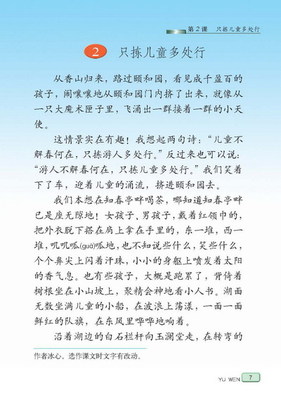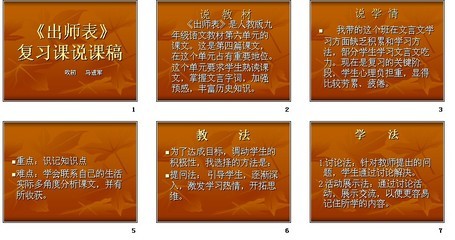Part One Analysis of the Teaching Material
(一) STATUS AND FUNCTION
1.This is an important lesson in Book One. From this lesson, itstarts asking the Ss to grasp contents of each Sample. To attain“four skills” request of listening, speaking, reading and writing.To start listing “Word Bank” and tell the Ss to remember the newwords. To start asking the Ss to write the English sentences well.Therefore this lesson is in the important position of the teachingmaterial.
2.This lesson is the first one of Unit 2.So if the Ss can learn itwell, it will be helpful to make the Ss learn the rest of thisunit.
3.Such a topic is related to daily life, so it is helpful to raiselearning interests of students and it will be also helpful toimprove their spoken English.
(二)ANALYSIS OF THE STUDENTS
The Ss has learned English for about one month so far. They canunderstand some words and some simple sentences. The Ss have takena great interest in English now.
(三)TEACHING AIMS AND DEMANDS
The teaching aim's basis is established according to Junior SchoolEnglish syllabus' provision.
1.Knowledge objects
(1) To make the Ss know how to use the affirmative sentence “Thisis. . . .” and the negative sentence “This is not….”Everydayexpressions for “Apologies”“I'm sorry”“That's all right”.
(2) To study the new words “six, hey, sorry, it’s, that’s”, etc. bylearning the dialogue of this lesson.
(3) To finish some exercises.
2.Ability objects
(1) To develop the Ss’ abilities of listening, speaking, readingand writing.
(2) To train the Ss’ ability of working in pairs.
(3) To develop the Ss’ abilities of communication by learning theuseful structures.
3.Moral objects
(1) To enable the Ss to be polite and love life.
(2) To enable the Ss to look after their things well.
(四)TEACHING KEY AND DIFFICULT POINTS
The teaching key and difficult points’ basis is establishedaccording to Sample A of Lesson Six in the teaching material'sposition and function.
1.Key points:
(1).To help the Ss to communicate with each other.
(2).To enable the Ss to study in groups and co-operateskillfully.
(3).To develop the Ss’ interest in English.
2.Difficult points:
(1) How to make dialogues and act them out.
(2) How to write the right whole sentences.
(五) TEACHING AIDS
Multi-media computer, Tape recorder, Software: Powerpoint orAuthorware, school things and so on. They will be needed in thislesson.
Part Two The Teaching Methods
1. Communicative teaching method
2. Audio-visual teaching method
3. Task-based” teaching method
As we all know: the main instructional aims of learning English inthe Middle School is to cultivate students’ abilities of listening,speaking, reading, writing and their good sense of the Englishlanguage. So in this lesson I’ll mainly use “Communicative”teaching method, “Audio-visual” teaching method and “Task-based”teaching method. That is to say, I’ll let the Ss to get a betterunderstanding of the key structure of the dialogue. I’ll give theSs some tasks and arrange five kinds of activities: talking,guessing games, watching CAI, acting out Sample A and having acompetition.
Teaching special features
To use these methods are helpful to develop the Ss’ thought.
Part Three STUDYING WAYS
1.Teach the Ss how to be successful language learners.
2.Let the Ss pass "Observation—Imitation—Practice " to studylanguage.
3.Teach the Ss how to master dialogues and how to communicate withothers.
Teaching special features:
Let the Ss communicate with each other and adopt competitionmethods to develop the Ss’ keen interest in English.
Part Four Teaching Procedure
I’ll finish this lesson in four steps. First I’ll divide the Ssinto four groups and bring a competition into the class. At lastlet’s see which group is the winner.
Step1 Warm-up
1. Free talk between T and Ss .
Such as: Hi, I’m . . . . What’s your name?
This is …. How do you do?
Who is he/she? How are you?
Who can count from 1to 5?
What’s this in English? etc.
2.A game: Ask the Ss to give T some school things. Forexample:
T: Give me your book.(ruler, box, pen, table, knife, etc.)
T: This is your book. This is not my book. It’s your book.etc.
In this course I’ll ask them to make a dialogue group by groupwithout repetition. Find out which group will make the mostdialogues.
Purpose of my designing: I think it is important to form a betterEnglish learning surrounding for the Ss by imitating and at thesame time it is necessary to provide situations to review learnedknowledge.
Step2. Presentation
This course is very important. I’ll mainly talk about thisstep.
I’ll use CAI to present the whole dialogue. Arrange some situationsto help Ss understand Sample A.
First scene: There is a bag on the floor. B is picking it up andget ready to leave. Now A is talking with B.
A: Hi, B. How are you today?
B: I’m fine, thank you. And you?
A: I’m fine, too. Oh, this is my bag.
B: No, this is not your bag. It’s my bag.
A: (Look closely) Oh, I’m sorry.
B: That’s all right.
(At the same time, C is running up and hitting A.)
C: Oh, I’m sorry.
A: That’s OK.
I’ll write the key points on the Bb while they are watching. Afterwatching, I’ll teach them to read the words and sentences on theBb. Make sure they can read them well.
Purpose of my designing: To present Sample A by CAI is much easierfor the Ss to learn and grasp the meanings. CAI can provide a realsituation with its sound and picture and it makes the relationshipsbetween the Ss better.
Step3.Practice
First play the tape recorder. Let the Ss listen and imitate thedialogue. Pay attention to their pronunciation and intonation. Inthis step the Ss are required to practise the Sample in pairs byreading the dialogue aloud. This step is employed to make the Ssgrasp the Sample .At last I’ll ask the Ss to think hard and act itout with a partner according to Sample A. Then find out which groupwill act it out well. I’ll give them red stars.
Purpose of my designing: This step is employed to make the Ss getthe general idea of the dialogue as a whole one. At the same timelet the Ss have a chance to practise their listening and spokenability.
Step4.Production
In this step I’ll give the Ss a free space to show theirabilities.
Second scene: The Ss are having a picnic. It’s hot and they takeoff their coats and put them together. They are singing anddancing, laughing and chatting. After the picnic, they begin tolook for their coats. D and E are talking. F and G are talking.etc.
After watching, I’ll give the Ss some tasks to make similardialogues without repetition and find out which group will makemore dialogues.
Purpose of my designing: “Task-based” teaching method is used hereto develop the Ss’ ability of communication and also their abilityof co-operation will be well trained. Tell the Ss we should bepolite and take good care of our things. We should love our life. Ithink proper competition can arouse the Ss’ interest in Englishlearning. If the Ss can finish this task well, they will benefit alot in their spoken English.
2.Skill 1 Model 1.
I’ll ask four Ss of the groups to write these sentences on the Bbin the four lines.
Then check their handwriting, correct their mistakes. Find out whowill write well and whose handing is the best.
3.Finish the Ss’ workbook.
Purpose of my designing: To check the knowledge Ss have learned inthis lesson.
Step5.Homework:
(1)Recite the words as many as possible after class.
(2)Make a dialogue according to Sample A and write it in theexercise book.
Purpose of my designing: I think homework is so important that theSs should speak English as much as they can in class or afterclass. It is necessary for the Ss to do some extensive exercisesafter class to consolidate the knowledge they learned.
Lesson Six Sample ASix This is my….hey This is not your. . . .sorryIt’s my. . . . Picture it’s=it is Oh, I’m sorry.that’s=that isThat’s all right/OK.
 爱华网
爱华网



